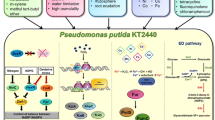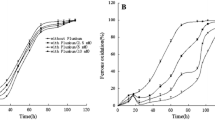Abstract
Aluminum (Al) triggered a marked increase in reactive oxygen species (ROS) such as O −2 and H2O2 in Pseudomonas fluorescens. Although the Al-stressed cells were characterized with higher amounts of oxidized lipids and proteins than controls, NADPH production was markedly increased in these cells. Blue native polyacrylamide gel electrophoresis (BN-PAGE) analyses coupled with activity and Coomassie staining revealed that NADP+ -dependent isocitrate dehydrogenase (ICDH, E.C. 1.1.1.42) and glucose-6-phosphate dehydrogenase (G6PDH, E.C. 1.1.1.49) played a pivotal role in diminishing the oxidative environment promoted by Al. These enzymes were overexpressed in the Al-tolerant microbes and were modulated by the presence of either Al or hydrogen peroxide (H2O2) or menadione. The activity of superoxide dismutase (SOD, E.C. 1.15.1.1), an enzyme known to combat ROS stress was also increased in the cells cultured in millimolar amounts of Al. Hence, Al-tolerant P. fluorescens invokes an anti-oxidative defense strategy in order to survive.









Similar content being viewed by others
References
Amir-Ahmady B, Salati LM (2001) Regulation of the processing of glucose-6-phosphate dehydrogenase mRNA by nutritional status. J Biol Chem 276(13):10514–10523
Anderson S et al (1992) A novel role for calcite in calcium homeostasis. FEBS Lett 308(1):94–96
Appanna VD et al (1995) Microbial adaptation to aluminum. Biotech Prog 11:159–166
Beriault R (2004) The metabolic network involved in the survival of Pseudomonas fluorescens exposed to Gallium, a Pro-oxident and an iron mimetic. In: Chemistry and Biochemistry. Laurentian University, Sudbury, pp 174
Boonstra J, Post JA (2004) Molecular events associated with reactive oxygen species and cell cycle progression in mammalian cells. Gene 337:1–13
Bradford MM (1976) A rapid and sensitive method for the quantitation of microgram quantities of protein utilizing the principle of protein-dye binding. Anal Biochem 72:248–254
Caldwell JM, Hassan HM (2002) Azotobacter chroococcum does not contain sodA or its gene product Mn-superoxide dismutase. Can J Microbiol 48(2):183–187
Cheng ML et al (2004) Glucose-6-phosphate dehydrogenase-deficient cells show an increased propensity for oxidant-induced senescence. Free Radic Biol Med 36(5):580–591
Contreras-Shannon V, McAlister-Henn L (2004) Influence of compartmental localization on the function of yeast NADP+-specific isocitrate dehydrogenases. Arch Biochem Biophys 423(2):235–246
Exley C, Birchall JD (1992) The cellular toxicity of aluminium. J Theor Biol 159(1):83–98
Fang J, Beattie DS (2003) External alternative NADH dehydrogenase of Saccharomyces cerevisiae: a potential source of superoxide. Free Radic Biol Med 34(4):478–488
Fridovich I (1974) Superoxide dismutases. Adv Enzymol Relat Areas Mol Biol 41(0):35–97
Hamel R et al (2004) Overexpression of isocitrate lyase is an important strategy in the survival of Pseudomonas fluorescens exposed to aluminum. Biochem Biophys Res Commun 317(4):1189–1194
Hamel R, Appanna VD (2003) Aluminum detoxification in Pseudomonas fluorescens is mediated by oxalate and phosphatidylethanolamine. Biochim Biophys Acta 1619(1):70–76
Kawano T et al (2003) Aluminum-induced distortion in calcium signaling involving oxidative bursts and channel regulation in tobacco BY-2 cells. Biochem Biophys Res Commun 308(1):35–42
Kayashima T, Katayama T (2002) Oxalic acid is available as a natural antioxidant in some systems. Biochim Biophys Acta 1573(1):1–3
Kermici M et al (1990) Evidence for an age-correlated change in glutathione metabolism enzyme activities in human hair follicle. Mech Ageing Dev 53(1):73–84
Koch OR et al (2004) Oxidative stress and antioxidant defenses in ethanol-induced cell injury. Mol Aspects Med 25(1–2):191–198
Maeng O et al (2004) Cytosolic NADP(+)-dependent isocitrate dehydrogenase protects macrophages from LPS-induced nitric oxide and reactive oxygen species. Biochem Biophys Res Commun 317(2):558–564
Middaugh J et al (2005) Aluminum triggers decreased aconitase activity via Fe-S cluster disruption and the overexpression of isocitrate dehydrogenase and isocitrate lyase: a metabolic network mediating cellular survival. J Biol Chem
Nayak P (2002) Aluminum: impacts and disease. Environ Res 89(2):101–115
Oteiza PI et al (2004) Metals in neurodegeneration: involvement of oxidants and oxidant-sensitive transcription factors. Mol Aspects Med 25(1–2):103–115
Romanov V et al (1999) Assays for allantoinase. Anal Biochem 268(1):49–53
Sailaja YR et al (2003) The antioxidant status during maturation of reticulocytes to erythrocytes in type 2 diabetics. Free Radic Biol Med 35(2):133–139
Schagger H, von Jagow G (1991) Blue native electrophoresis for isolation of membrane protein complexes in enzymatically active form. Anal Biochem 199(2):223–231
Vendemiale G et al (2001) Mitochondrial oxidative injury and energy metabolism alteration in rat fatty liver: effect of the nutritional status. Hepatology 33(4):808–815
Wrenger C, Muller S (2003) Isocitrate dehydrogenase of Plasmodium falciparum. Eur J Biochem 270(8):1775–1783
Wynn JP et al (1997) Sesamol as an inhibitor of growth and lipid metabolism in Mucorcircinelloides via its action on malic enzyme. Lipids 32(6):605–610
Yumoto I et al (2000) Purification and characterization of a catalase from the facultatively psychrophilic bacterium Vibrio rumoiensis S-1(T) exhibiting high catalase activity. J Bacteriol 182(7):1903–1909
Zatta P et al (2000) Effects of aluminum on activity of krebs cycle enzymes and glutamate dehydrogenase in rat brain homogenate. Eur J Biochem 267(10):3049–3055
Acknowledgements
This work was supported by fundings from Human Resources and Development Canada and NATO.
Author information
Authors and Affiliations
Corresponding author
Additional information
Communicated by K. Horikoshi
Rights and permissions
About this article
Cite this article
Singh, R., Beriault, R., Middaugh, J. et al. Aluminum-tolerant Pseudomonas fluorescens: ROS toxicity and enhanced NADPH production. Extremophiles 9, 367–373 (2005). https://doi.org/10.1007/s00792-005-0450-7
Received:
Accepted:
Published:
Issue Date:
DOI: https://doi.org/10.1007/s00792-005-0450-7




